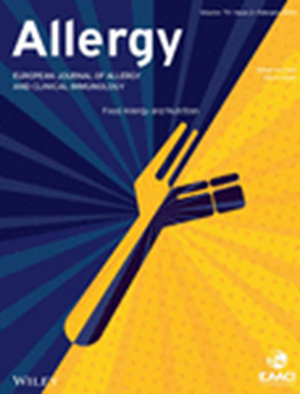Real‐World Effectiveness for Sublingual Allergen Immunotherapy Among School‐Aged Children and Adolescents
IF 12.6
1区 医学
Q1 ALLERGY
引用次数: 0
Abstract
BackgroundSublingual allergen immunotherapy (SLIT) is a safe and effective treatment of allergic rhinitis, and its use has been increasing in recent years. Although several randomized and observational studies showed the effectiveness of SLIT among adults and children aged > 12 years, its extent remains unclear in nationwide routine healthcare settings for school‐aged children.MethodsWe conducted a propensity score (PS)‐matched cohort study using a nationwide administrative database. Data from 13,449 individuals who received SLIT for house dust mites between 2015 and 2021 were extracted and matched with data from 1,732,961 individuals who did not. The PS‐matching procedure created 10,985 pairs and followed them for three years, totaling 812,795 person‐months. Then, we compared healthcare costs, resource use, and prescriptions between the SLIT and control groups over the three years.ResultsThe introduction of SLIT was associated with an 8.9% reduction in antibiotic use (95% CI, 12.0% to 34.7%) and a 65.2% reduction in hospitalizations (95% CI, 52.8% to 74.4%), as well as a 44.1% increase in health resource utilization (95% CI, 40.7% to 47.6%), with minimal impact on overall healthcare costs (+8.9% [95% CI, −12.0% to +34.7%]) over the three‐year follow‐up period. Similar findings were observed in event‐study design and intention‐to‐treat analyses, as well as in age‐stratified analyses (ages 5–10 years and 11–19 years).ConclusionsThe introduction of SLIT for house dust mites was associated with a reduction in antibiotic prescriptions and hospitalizations among children aged 5–19 years with minimal impact on healthcare costs, demonstrating sustained benefits over three years.学龄儿童和青少年舌下过敏原免疫治疗的实际效果
舌下过敏原免疫疗法(SLIT)是一种安全有效的治疗变应性鼻炎的方法,近年来其应用越来越广泛。尽管一些随机和观察性研究表明SLIT在成人和儿童中的有效性。12年后,其在全国学龄儿童常规保健机构中的程度仍不清楚。方法:我们使用全国行政数据库进行倾向评分(PS)匹配的队列研究。研究人员提取了2015年至2021年间接受SLIT治疗的13449人的数据,并将其与未接受SLIT治疗的1732961人的数据进行了匹配。PS匹配程序创建了10,985对配对,并对其进行了三年的跟踪,总计812,795人月。然后,我们比较了三年来SLIT组和对照组之间的医疗成本、资源使用和处方。结果SLIT的引入与抗生素使用减少8.9% (95% CI, 12.0%至34.7%),住院率减少65.2% (95% CI, 52.8%至74.4%)以及卫生资源利用率增加44.1% (95% CI, 40.7%至47.6%)相关,对总体医疗成本的影响最小(+8.9% [95% CI, - 12.0%至+34.7%])在三年随访期间。在事件研究设计和意向治疗分析以及年龄分层分析(5-10岁和11-19岁)中也观察到类似的结果。结论:采用SLIT治疗室内尘螨可减少5-19岁儿童的抗生素处方和住院治疗,对医疗费用的影响最小,并显示出持续三年的效益。
本文章由计算机程序翻译,如有差异,请以英文原文为准。
求助全文
约1分钟内获得全文
求助全文
来源期刊

Allergy
医学-过敏
CiteScore
26.10
自引率
9.70%
发文量
393
审稿时长
2 months
期刊介绍:
Allergy is an international and multidisciplinary journal that aims to advance, impact, and communicate all aspects of the discipline of Allergy/Immunology. It publishes original articles, reviews, position papers, guidelines, editorials, news and commentaries, letters to the editors, and correspondences. The journal accepts articles based on their scientific merit and quality.
Allergy seeks to maintain contact between basic and clinical Allergy/Immunology and encourages contributions from contributors and readers from all countries. In addition to its publication, Allergy also provides abstracting and indexing information. Some of the databases that include Allergy abstracts are Abstracts on Hygiene & Communicable Disease, Academic Search Alumni Edition, AgBiotech News & Information, AGRICOLA Database, Biological Abstracts, PubMed Dietary Supplement Subset, and Global Health, among others.
 求助内容:
求助内容: 应助结果提醒方式:
应助结果提醒方式:


